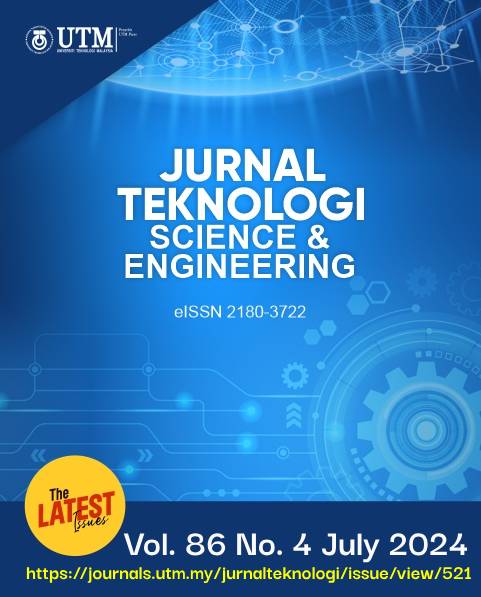INTERLOCKING BRICKS AND PRISMS USING WASTE GLASS AGGREGATES BY INTEGRATING GEOPOLYMER TECHNOLOGY
DOI:
https://doi.org/10.11113/jurnalteknologi.v86.21699Keywords:
Interlocking Bricks, Fly ash, GGBS, Waste Glass, PrismAbstract
An attempt has been made to develop sustainable and low-cost geopolymer interlocking bricks using the binders namely Ground Granulated Blast Furnace Slag (GGBS) and fly ash by activating them with hydroxides and silicates of sodium. M-Sand is used in combination with waste glass as fine aggregates. Seven mix ratios adopted are : Bricks with 100% M-Sand, 90% M-Sand and 10% waste glass, 80% M-Sand and 20% waste glass, 70% M-Sand and 30% waste glass, 60% M-Sand and 40% waste glass, 50% M-Sand and 50% waste glass and 40% M-Sand and 60% waste glass. Physical tests were conducted for all the materials used. In total, eighty-four interlocking bricks of size 300 mm x 200mm x 125mm were cast and the bricks were kept in room temperature for 28 days. Interlocking bricks were then tested for density, compressive strength and water absorption. Prisms of length 600 mm, height 375 mm and width 200 mm were constructed using three layers of interlocking bricks and subjected to compressive load. Interlocking bricks with 70% M-Sand and 30% Waste glass exhibited maximum compressive strength and low water absorption. Prisms with 70% M-Sand and 30% waste glass has maximum ultimate load carrying capacity and energy Absorption.
References
Seung Bum Park, Bong Chun Lee and Jeong Hwan Kim. 2004. Studies on Mechanical Properties of Concrete Containing Waste Glass Aggregate. Cement and Concrete Research. 34(12): 2181-2189.
Doi: https://doi.org/10.1016/j.cemconres.2004.02.006.
Dabiri, H., Sharbatdar, M. K., Kavyani, A., and Baghdadi M. 2018. The Influence of Replacing Sand with Waste Glass Particle on the Physical and Mechanical Parameters of Concrete. Civil Engineering Journal. 4(7): 1646-1652.
Doi: 10.28991/cej-03091101.
Edward Harrison, Aydin Berenjian and Mostafa Seifan. 2020. Recycling of Waste Glass as Aggregate in Cement-based Materials. Environmental Science and Ecotechnology. 4(100064): 1-8.
Doi: https://doi.org/10.1016/j.ese.2020.100064.
Zeybek, Özer, Yasin Onuralp Özkılıç, Memduh Karalar, Ali İhsan Çelik, Shaker Qaidi, Jawad Ahmad, Dumitru Doru Burduhos-Nergis, and Diana Petronela Burduhos-Nergis. 2022. Influence of Replacing Cement with Waste Glass on Mechanical Properties of Concrete. Materials. 15(21): 7513.
Doi: https://doi.org/10.3390/ma15217513.
Olofinnade, Oluwarotimi & Chigere, Cynthia & Nduka, David & Joshua, Opeyemi & Fatai and Ogunbayo. 2020. Novel Mortar Containing Waste Glass and Clay Brick Powder for Sustainable Construction. Proceedings of International Structural Engineering and Construction. 7. Doi: 10.14455/ISEC.res.2020.7(1).SUS-10.
Photisan, Methawee Sriwattanapong; Sangphong and Onanong. 2022. Strength Development of Fly Ash-Perlite Based Geopolymer Mortar Using Recycled Waste Glass as Fine Aggregate. Naresuan University Journal: Science and Technology (NUJST). 31(1): 1-9,
Doi: https://doi.org/10.14456/nujst.2023.1.
Tayfun Uygunoglu, Ilker Bekir Topcu, Osman Gencel and Witold Brostow. (2012). The Effect of Fly Ash Content and Types of Aggregates on the Properties of Pre-fabricated Concrete Interlocking Bricks (PCIBS). Construction and Building Materials. 30: 180-187.
Doi: 10.1016/j.conbuildmat.2011.12.020.
Mohammed, B. S., Liew, M. S., Alaloul, W. S., Al-Fakih, A., Ibrahim, W., and Adamu M. 2018. Development of Rubberized Geopolymer Interlocking Bricks. Case Studies in Construction Materials. 8: 401-408.
Doi: 10.1016/j.cscm.2018.03.007.
Alaloul, W. S., John, V. O., and Musarat M. A. 2020. Mechanical and Thermal Properties of Interlocking Bricks Utilizing Wasted Polyethylene Terephthalate. International Journal of Concrete Structures and Materials. 14: 24.
Doi: https://doi.org/10.1186/s40069-020-00399-9.
Xiao, R., Polaczyk, P., Zhang, M., Jiang, X., Zhang, Y., Huang, B., and Hu W. 2020. Evaluation of Glass Powder-Based Geopolymer Stabilized Road Bases Containing Recycled Waste Glass Aggregate. Transportation Research Record. 2674(1): 22-32.
Doi: https://doi.org/10.1177/0361198119898695.
Hindavi R. Gavali, Ana Bras, Paulina Faria, Rahul V and Ralegaonkar. 2015. Development of sustainable alkali-activated bricks using industrial wastes. Construction and Building Materials. 215: 180-191.
Doi: https://doi.org/10.1016/j.conbuildmat.2019.04.152.
KejkarRupali B and WanjariSwapnil P. 2021. Sustainable Production of Commercially Viable Alkali-activated Bricks, Proceedings of the Institution of Civil Engineers - Engineering Sustainability. 174(3): 109-119.
Doi: https://doi.org/10.1680/jensu.20.00001.
Nabil Hossiney, Hima Kiran Sepuri, Mothi Krishna Mohan, Sarath Chandra K, Srinidhi Lakshmish Kumar and Thejas H K. 2020. Geopolymer Concrete Paving Blocks Made with Recycled Asphalt Pavement (RAP) Aggregates Towards Sustainable Urban Mobility Development. Cogent Engineering. 7: 1
Doi: 10.1080/23311916.2020.1824572.
Youssef, N., Rabenantoandro, A. Z., and Dakhli Z. 2019. Reuse of Waste Bricks: A New Generation of Geopolymer Bricks. SN Applied Sciences. 1: 1252.
Doi: https://doi.org/10.1007/s42452-019-1209-6.
Toniolo, Nicoletta & Taveri, Gianmarco & Hurle, Katrin & Roether, Judith & Ercole, Piero & Dlouhy, Ivo & Boccaccini and Aldo. 2017. Fly-Ash-Based Geopolymers: How the Addition of Recycled Glass or Red Mud Waste Influences the Structural and Mechanical Properties. Journal of Ceramic Science and Technology. 8: 411-419.
Doi: 10.4416/JCST2017-00053.
Amin, S. K., El–Sherbiny, S. A., El–Magd, A. A. M. A., Belal, A., and Abadir M. F. 2017. Fabrication of Geopolymer Bricks using Ceramic Dust Waste. Construction and Building Materials. 157: 610-620.
Doi: 10.1016/j.conbuildmat.2017.09.052.
IS 3812. 2003. Specification for Fly Ash for Use as Pozzolana and Admixture, Bureau of Indian Standards (BIS). New Delhi, India.
BS 6699. 1992. Specification for Ground Granulated Blast Furnace Slag for Use with Portland Cement. British Standards Institution: United Kingdom.
IS 2386 (Part IV -1963). Method of Test for Aggregates for Concrete -Mechanical Properties. Bureau of Indian Standards (BIS): New Delhi, India.
IS 383. 2016. Specifications for Coarse and Fine Aggregate from natural sources for concrete. Bureau of Indian Standards (BIS): New Delhi, India.
IS 2185. 2005. Concrete Masonry Units – Specification, Hollow and Solid Concrete Blocks. Bureau of Indian Standards (BIS): New Delhi, India.
Al-Fakih, Amin & Mohammed, Bashar & Nuruddin, Fadhil & Nikbakht and Ehsan. 2018. Development of Interlocking Masonry Bricks and its’ Structural Behaviour: A Review Paper. IOP Conference Series: Earth and Environmental Science. 140. 012127.
Doi: 10.1088/1755-1315/140/1/012127.
Jaafar, Mohd & Thanoon, Waleed & Najm, Amad & Abdulkadir, Mohd & Ali and Abang. 2006. Strength Correlation between Individual Block, Prism And Basic Wall Panel for load Bearing Interlocking Mortarless Hollow Block Masonry. Construction and Building Materials. 20: 492-498.
Doi: 10.1016/j.conbuildmat.2005.01.046.
Downloads
Published
Issue
Section
License
Copyright of articles that appear in Jurnal Teknologi belongs exclusively to Penerbit Universiti Teknologi Malaysia (Penerbit UTM Press). This copyright covers the rights to reproduce the article, including reprints, electronic reproductions, or any other reproductions of similar nature.
















